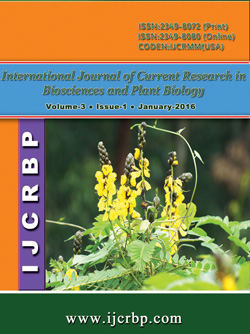 |
Online ISSN : 2349-8080 Issues : 12 per year Publisher : Excellent Publishers Email : editorinchiefijcrbp@gmail.com |
Faculty of Science, University of Yaounde I, BP: 16 591 Yaoundé, Cameroon
This survey articulates around three aims; (1) to study the vegetation structure and woody species diversity in the hilly Oku sacred forest (2200-2300m of altitude) of northwestern Cameroon, (2) to compare our results with those of other tropical sacred forests, and (3) to appreciate the hygrothermality of the plant species. A quantitative inventory was realized on trees with diameter at breast height > 10cm covering a cumulative surface area of 1.25-ha, from 9 rectangular plots of 50m x 25m (1250m2 ). Standard methodology to calculate floristic diversity was employed. A total of 934 trees belonging to 31 species, 27 genera and 19 families were recorded with a total basal area of 246.87m2 per hectar. Most trees had a height between 10 and 15m and diameter of 10-20cm. However some individuals reached heights of 25 to 30m. Three species namely Schefflera abyssinica (1 individual), Schefflera mannii (2 individuals) and Syzygium guineense (2 individuals) had a diameter of 220-230cm. The 4 most important families in term of density, diversity and dominance were Araliaceae, Myrtaceae, Meliaceae and Rubiaceae. They represented 150.7 of Family Importance Value (FIV). The species composition was dominated by five common species (16.12%) (Schefflera mannii, Carapa grandiflora, Syzygium guineense, Xymalos monospora and Piptadeniastrum africanum), representing 162.47 of the Index of Value importance (IVI). Three plant species were represented by only one individual. The peculiarity of the Oku sacred forest is the presence and high IVI (26.55) of Piptadeniastrum africana, the lone Leguminosae, a characteristic of mesophile forests (order of the PiptadenioCeltidetalia). The Oku sacred forest has low species diversity, considerably high stem abundance compared to most forests of tropical regions and a highest dominance. The forest structure and formation is characterised by big trees (in terms of diameter), covered from top to bottom by the strangler epiphytes. With respect to species climatological considerations, the Oku sacred forest is dominated by hygro-oligothermal (afro-montane) vegetation, hygro-mesothermal (submontane) vegetation and hygromegathermal (lower and middle altitudes) vegetation. All these characteristics argue for the syngenetic status of Oku sacred forest.
